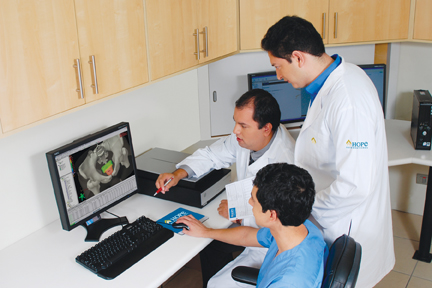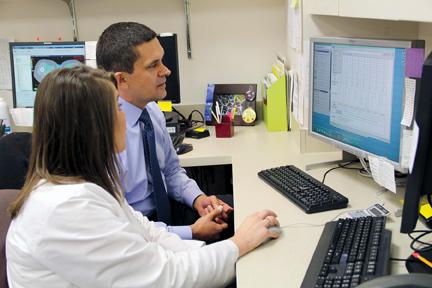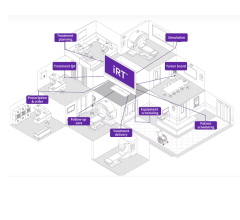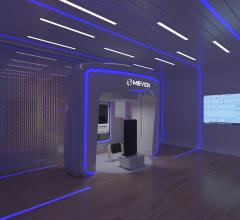
New features added to treatment planning systems have not made dosimetrists more efficient. Treatment planning takes anywhere from one to six days.
Treatment planning systems have been an integral part of radiation therapy since the 1980s; however, today’s systems are more technologically advanced. Back then dosimetrists would sit in front of a computer all day long contouring and planning out treatments for patients. Afterward, physicians and physicists would review the plans. Although the fundamental workflow has not changed much, as technology improves, new features are continually added to the systems to allow physicians to get more out of them than ever before.
Integration of Advanced Image Processing and Analysis
One new feature that physicians are now seeing is more integration of advanced image processing and analysis tools. “Now we are seeing more and more advanced contouring support for multimodality imaging,” said Sasa Mutic, Ph.D., director of clinical medical physics and professor of radiation oncology, Mallinckrodt Institute of Radiology, Washington University School of Medicine, Missouri.
The integration of advanced image processing and analysis will continue to expand as treatment planning systems evolve. “Features of the treatment planning systems will move toward the imaging devices to where they will be integrated in CT or MR scanners,” Mutic said. This movement toward imaging scanners will likely result in the ability to image patients on treatment machines, allowing physicians the ability to plan right there or adjust treatment based on the image. “We think that this will hit what we do day-to-day pretty soon,” he stated.
Decision Support and Benchmarking
A trend that physicians in radiation oncology and treatment planning have seen is the increase of retreatment patients. With retreatment, the same patient receives multiple courses of radiation treatments, often for different tumor sites. This trend can be credited to physicians doing a better job with treatment, which results in patients living longer and then treating the same patients over multiple years.
Retreatment has given rise to the need for integration of decision support tools. These knowledge-based, decision-making and benchmarking tools allow physicians to use knowledge gained from the treatment of prior patients with incoming patients. Many physicians hope that integration of decision and benchmarking tools will continue because it makes a big difference in patient outcomes.
These tools also allow physicians to monitor one patient over different periods of treatment. Because physicians are seeing patients multiple times, and possibly more frequently, being able to integrate previous treatment plans from one course of therapy to another is becoming a significant factor. “I think that we will see an increase in tools that enable this type of longitudinal care,” Mutic said.
Automation in Protocols
The implementation of decision support and benchmarking tools is greatly facilitated by standardization of treatment protocols and practices, and this is one aspect of treatment planning that still requires additional improvements. The lack of automation and standardization dates back to the early days of use when there was more variability within the treatment planning systems themselves. Ten or 15 years ago there were clinics that had older technology and clinics that had newer technology. As time has passed and technology improved, the variability of the actual systems has decreased. Today, virtually anyone can go out and buy a top-of-the-line treatment planning system. This standardization in equipment offers an opportunity to standardize how the equipment is actually used.
Although obtaining top-of-the-line equipment and software is much easier today — enabling clinics to have similar technological capabilities across the board — there is a lot of variability in how the equipment is used. This can lead to variability in outcomes with potentially significant effects for patients. “Scientific papers have shown that if you have variability in research protocol compliance, patients don’t have as good outcomes. We believe that’s likely the same situation in the routine clinical practice,” Mutic said. If physicians cannot treat patients consistently, or if they do not have a way to ensure that an individual patient treatment meets the benchmarks of what is possible or what has been done for other patients in the past, this may directly affect outcomes and side effects. Because of this, physicians can expect vendors to introduce tools that enable everyone to use the technology the same way in the near future — regardless of whether they are a novice or an expert. This will ensure that treatment plans are more consistent from one patient to another, and also from one clinic to another.
Workforce and Training Constraints
The many additional features that have been and will be added to treatment planning systems allow for more possibilities in treatment; however, they have not helped streamline the process needed for utilization. There is no question that systems are becoming more complex, and in many cases this is in the direction of being safer for patients. Systems are better thought out and have more interlocks and internal features that prevent users from mistreating patients. But with these more complex systems has come the need for additional time in training to ensure that everyone is aware of how the systems work. According to Mutic, Mallinckrodt Institute of Radiology uses about 5 percent of its full-time employees just for training and improving how the institute utilizes its treatment planning system. “The treatment systems are becoming more diverse just from the use of imaging and more complicated treatment techniques, so there is definitely more that a person needs to know about these systems,” he said.
Not only has training become a lengthier and more labor-intensive process, the addition of new features has not made dosimetrists more efficient. Treatment planning still takes anywhere from one to six days worth of work, depending on what is being planned. “Processing a patient often takes up to 20 man-hours of someone touching the planning system,” Mutic said. “We haven’t been able to reduce our workforce.”
Although physicians are now able to do more with the same number of people — a few more people may even be needed now — with the state of healthcare, it would be more economically feasible for clinics if the systems were less labor-intensive. “The money that goes toward the people that operate planning systems is a large fraction of our expenses, and the ability to automate some of those things would go a long way,” he said. This is another update that physicians can expect to see in the future, along with improvements for overall simplification. “I’ve talked with vendors several times and told them that for every feature that is introduced, they should really take two off because at some point in time we will just have too many features to be able to keep up with labor and with the understanding,” he concluded.



 December 04, 2025
December 04, 2025 









